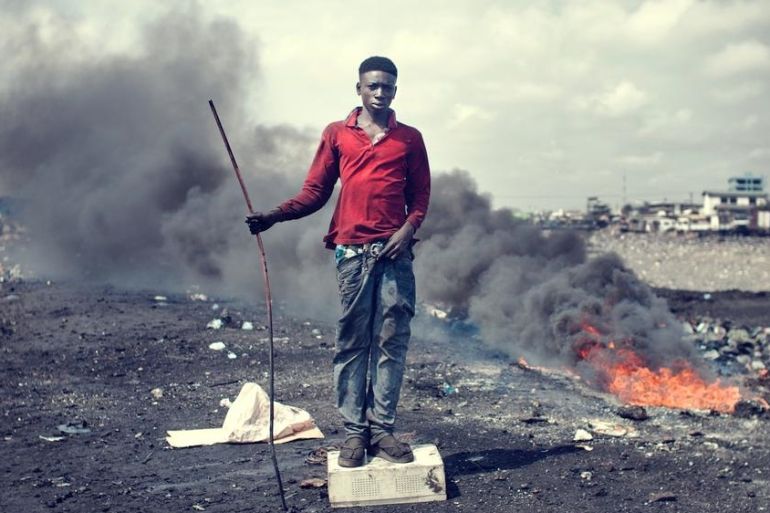Climate change in pictures
The images that capture the consequences of our changing climate on the people most affected by it.

Published On 17 Nov 2016
Ghana’s e-waste magnet
![Agbogbloshie is the world's biggest e-waste dumpsite and is located near Accra, Ghana. Electronic waste - TVs, PCs, hi-fi systems, refrigerators - defines the landscape of this former wetland and recreation area. Here in Agbogbloshie, boys and men aged between seven and 25 smash stones and simple tools against TVs and PCs to get to the metals, particularly the copper. They will earn about $2.50 for a day's work. Most of them left families in the impoverished northern and upper west regions of Ghana when they came to work here. [Kevin McElvaney/Al Jazeera]](/wp-content/uploads/2016/11/54a28c5f27d04fc09f7935220f6a0cfc_18.jpeg)
Madagascar: On the hunt for sharks
![Driven by the collapse of local fisheries, increasing weather extremes and poverty, as well as the opportunity to earn money by selling shark fins and sea cucumbers to the Chinese market, the fishermen of southwest Madagascar have been leaving their homes in increasing numbers and migrating greater distances to places where they can still find productive fishing grounds. The fishermen travel to the most remote parts of Madagascar's west coast. Often living far offshore on tiny islands in the Mozambique Channel, they eke out a living in places with no potable water or food and no access to hospitals or schools. [Garth Cripps/Al Jazeera]](/wp-content/uploads/2016/06/bf6c740f30bd4fa980c39e6007f7170c_8.jpeg)
Surviving climate change in Bangladesh
![As one of the world's most densely populated countries, situated over the delta where three of Asia's largest rivers - the Ganges, Brahmaputra, and Meghna - meet, Bangladesh feels the effects of a changing climate intensely. The 150 million inhabitants of Bangladesh adapt, cope and innovate in the face of this change. Many have migrated to the capital, Dhaka, and other cities further inland, which has caused the population in these cities to swell and living conditions to deteriorate. [Karim Mostafa/Al Jazeera]](/wp-content/uploads/2016/07/f2d44d5628514fcba81a47a018513f9a_8.jpeg)
The Badjao: Nomads of the sea
![The Badjao are a sea-dwelling tribe, often known as the 'Sea Nomads', who have been floating off the shores of Southeast Asia for centuries. As a nomadic tribe living in stilt huts or boat houses on shallow waters, they make their living from traditional free-diving for fish and pearls. As they belong to no official state and possess no official nationality, they find the move from sea to land a challenge. Because of their nomadic lifestyle, the Badjao are at a disadvantage with no schooling, healthcare or access to government-provided social services. [Guillem Valle/Al Jazeera]](/wp-content/uploads/2016/11/6f5def2a93b5447e8d51a0e2b7704ab8_18.jpeg)
Guinea Bissau Carnival celebrates diversity
![With instruments made from bamboo, plant-based face paints, and skirts woven from local fauna, groups at Guinea Bissau's Carnival dance competition displayed the biodiversity of their country. Teams of performers competed in ceremonial dances from the country's many ethnic groups in a carnival themed Rescue and Promote Our Culture. The dances represented traditional events such as the harvest and coming-of-age ceremonies. [Ricci Shryock/Al Jazeera]](/wp-content/uploads/2016/03/379c8de4df3d4dadaec24b762e5ce883_18.jpeg)
The Aral Sea springs back to life
![The little village of Tastubek is situated in the North Aral Sea, 90km from Aralsk, a former port on the Aral Sea. This part of what remains of the Aral Sea is known as the Small Aral. The Aral Sea was once the world's fourth-largest inland body of water, but has been for ever altered by the Soviet era irrigation policies to reclaim the desert for cotton farming by rerouting the Amu Darya and Syr Darya rivers. Akerke and her husband Nurzhan moved to the village a few years ago and make a living from fishing, an industry which, until recently, seemed to have been wiped out in this part of Kazakhstan. [Didier Bizet/Al Jazeera]](/wp-content/uploads/2016/11/c9bf946d35454998a00312ecdc043ad3_18.jpeg)
The hungry tide: Bay of Bengal’s sinking islands
![Ghoramara island is known as the 'sinking island'. Located 150km south of Kolkata in the Bay of Bengal's Sunderban delta, the island, once spanning more than 20 sq km, has been reduced to an area of just 5sq km. Global warming has caused the river to grow. Flowing down from the mighty Himalayas, the river brings more and more snowmelt along as it empties into the Bay of Bengal. High tides and floods play havoc on the fragile embankments, displacing hundreds of islanders every year. [Swastik Pal/Al Jazeera]](/wp-content/uploads/2016/11/71cb54ecad9b4e11adcf2274891ab112_18.jpeg)
Source: Al Jazeera